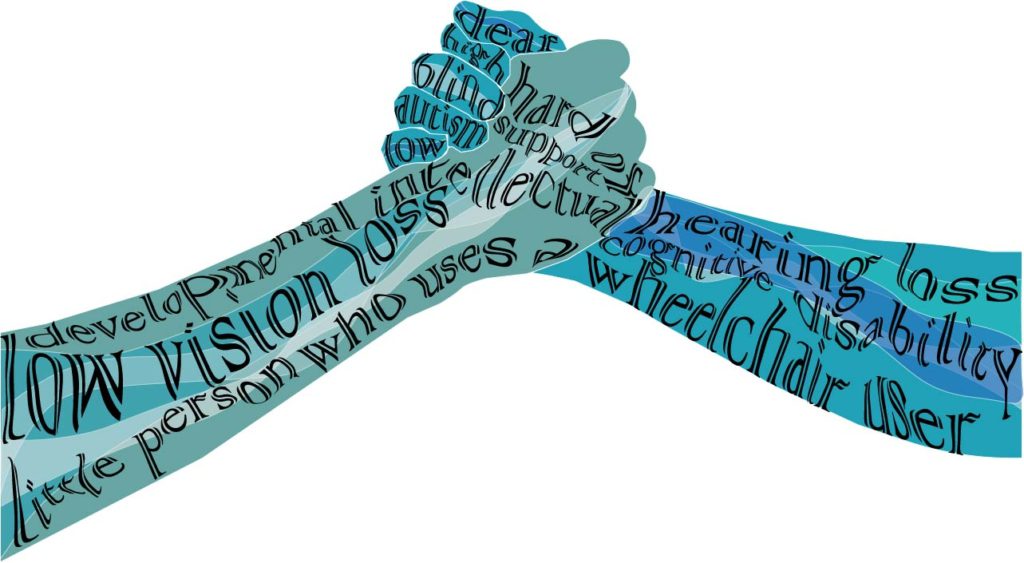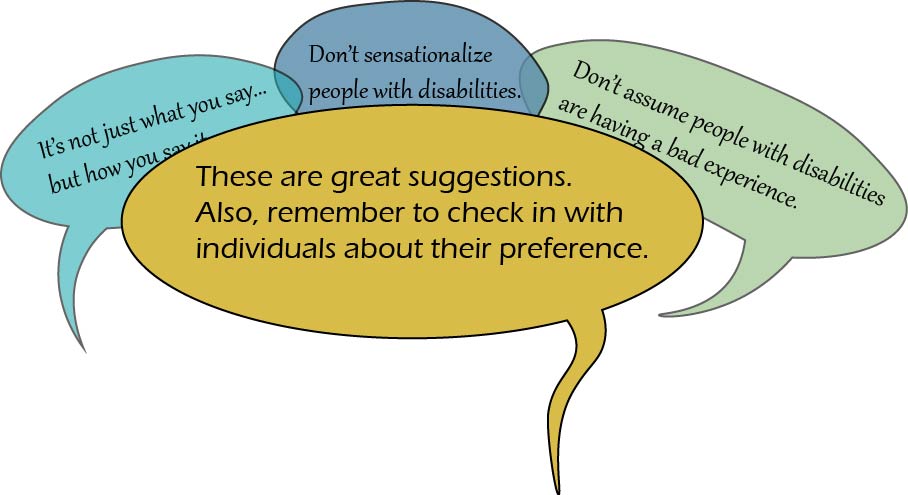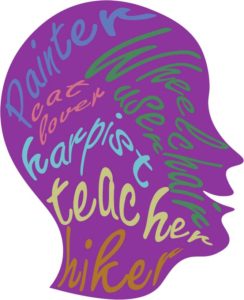समावेशी भाषा गाइड
Words matter. Consider the way you are speaking to and about students regarding all aspects of their identities. Identity traits can be visible or nonvisible. Insensitive or outdated word choices can reinforce stereotypes; stereotypes can perpetuate oppressive systems, negative connotations and create barriers. The goal of this guide is to provide you with tools to be inclusive and respectful in your language by putting the whole person at the center of your word choice.
 सीखना
सीखना
Language is subjective, constantly changing, and can be non-verbal. When interacting with an individual who has a disability, always default to what that individual prefers, even if that conflicts with what you think to be the “correct” language and note how your tone or inflection might be perceived.
 प्रयत्न
प्रयत्न
To feature art by artists of all abilities as masterworks in your residencies. You can find a variety of artists below or in the Inclusive Curriculum Guide.
 याद कीजिए
याद कीजिए
ऐसी भाषा से बचें जो मानती है कि विकलांग व्यक्ति को नकारात्मक अनुभव हो रहा है (यानी पीड़ित, चुनौती, समस्या, पीड़ित, आदि)। ऐसी भाषा से बचें जो एक विकलांग व्यक्ति (अर्थात अलौकिक, साहसी, बहादुर, प्रेरणा, आदि) को सनसनीखेज बनाती है।
समावेशी भाषा के लिए आशाजनक व्यवहार

Image credit: Jean Wong
It can be challenging to talk about language as it is very subjective, dynamic, and ever-evolving. This guide may conflict with terminology used by individuals, schools, organizations, and institutions with which you work. Often structural institutions and systems struggle to shift their language to keep up to speed with how language is changing. The guide below was made in a moment in time, and the most promising practice is to keep current with language as it changes.
भाषा अखंड नहीं है

Image credit: Jean Wong
- Using person-first language is a good place to begin when referring to individuals or groups of individuals with disabilities. Instead of “disabled student”, say “student with a disability”. This puts the focus on the individual over their diagnosis.
- व्यक्ति-प्रथम भाषा का उपयोग करके प्रारंभ करें, फिर व्यक्तियों के साथ जांचें कि वे कैसे पहचाने जाना चाहते हैं।
- Self-advocates and individuals with disabilities may disagree or have different preferences than what is listed here.
…Neither identity-first nor people-first language approaches should be applied broadly. There are some communities that strongly prefer people-first language. Those with intellectual disabilities usually prefer people-first language, and there are advocacy groups mainly run by and for people with intellectual disabilities around the globe called People First that date back to the 1970s. Conversely, the Autistic and Deaf communities both strongly prefer identity-first language for reasons that I’ve outlined above, as well as from a sense of disability pride.” Cara Liebowitz
- किसी अन्य व्यक्ति के विकलांगता के साथ जीने के अनुभव का नाम बताने या उसका वर्णन करने का कोई एक सही तरीका नहीं है। किसी व्यक्ति की पहचान प्राथमिकताओं को सामान्य शब्दों पर प्राथमिकता दी जानी चाहिए। हम आपको सीखने के लिए अपने छात्रों के साथ बातचीत करने और उपयुक्त होने पर उनके पसंदीदा पहचानकर्ता का उपयोग करने के लिए प्रोत्साहित करते हैं।
- No individual is only their diagnosis. So, unless there is a specific need for someone’s disability to be mentioned, focus on the student as an individual.
We are all on a learning journey! It can take time to adjust your language and thinking in a way that feels authentic to you. If you make a mistake and an individual corrects you, apologize, adjust and move on. Don’t fixate as that can draw more attention and make things worse.
पसंदीदा भाषा क्या करें और क्या न करें

Image credit: Jean Wong
| कर | नहीं |
|---|---|
| विकलांग व्यक्ति | अपंग व्यक्ति |
| क्यूं कर: There is great debate over whether to use person-first language (e.g. person with autism) vs. identity-first language (e.g. autistic person). The current best practice is to acknowledge the person before their disability, but always go with what the person prefers. विकलांगता के बारे में बात करने के लिए शब्द चुनना | |
| कर | नहीं |
|---|---|
| व्हीलचेयर उपयोगकर्ता, शारीरिक रूप से अक्षम व्यक्ति, व्हीलचेयर का उपयोग करने वाला व्यक्ति | विकलांग या व्हीलचेयर से बंधे, अपंग, विकृत, लंगड़े |
| क्यूं कर: विकलांग शब्द को अब अक्सर सुलभ शब्द से बदल दिया जाता है। परिभाषा के अनुसार, बाधा शब्द एक बाधा को संदर्भित करता है जो प्रगति को कठिन बना देता है। विकलांग व्यक्तियों के लिए, पर्यावरण या परिस्थिति बाधा या सीमित हो सकती है। व्यक्ति स्वयं बाधा नहीं है। इसी तरह, व्हीलचेयर-बाउंड शब्द यह संकेत देता है कि एक व्यक्ति अपने व्हीलचेयर द्वारा प्रतिबंधित या सीमित होता है जब अक्सर वे व्हीलचेयर के कारण अधिक पहुंच और अनुभव कर सकते हैं। अपंग, विकृत और लंगड़े स्वभाव से अपमानजनक और आक्रामक होते हैं। | |
| कर | नहीं |
|---|---|
| कम दृष्टि, दृष्टि हानि, अंधा | दृष्टि बाधित |
| क्यूं कर: जबकि "दृष्टि बाधित" को कभी स्वीकार्य माना जाता था, तब से इसे चरणबद्ध रूप से समाप्त कर दिया गया है। हानि नकारात्मक पर ध्यान केंद्रित करती है, जो एक व्यक्ति नहीं कर सकता है, और यह संकेत देता है कि एक व्यक्ति को ठीक करने की आवश्यकता है। कई आधिकारिक संसाधन अभी भी हानि शब्द का उपयोग करते हैं, लेकिन आमतौर पर इसे पसंद नहीं किया जाता है। Lauren "Lolo" Spencer talks about funny and ridiculous things that able-bodied people say with reference to her disability. |
|
| कर | नहीं |
|---|---|
| सुनने में कठिनाई, सुनने में परेशानी, बहरे या बहरे | बहरा |
| क्यूं कर: कम सुनने या कम सुनने की स्थिति का जिक्र करते समय बधिर शब्द में लोअरकेस "डी" का प्रयोग करें। एक समुदाय पहचान, या लोगों की संस्कृति का जिक्र करते समय बधिर शब्द में एक अपरकेस "डी" का प्रयोग करें। National Association of the Deaf on this Distinction. | |
| कर | नहीं |
|---|---|
| ASC (Autism Spectrum Condition) or autism | Asperger’s |
| क्यूं कर: Autism is a spectrum condition and when written can be referred to as ASC or autism. Asperger’s is capitalized as it is the name of a person. Asperger’s syndrome is no longer diagnosed, as all current diagnoses are currently seen as part of the autism spectrum. However, some individuals may still identify as having Asperger’s. | |
| कर | नहीं |
|---|---|
| छोटा व्यक्ति | बौना |
| क्यूं कर: The word, "midget" was never formally or clinically used in association with dwarfism. Instead, it was an adopted cultural label used to refer to people who were short in stature and on display for sport. Individuals with dwarfism advocate that the word midget is derogatory. Little People of America's statement to abolish the "m" word. | |
| कर | नहीं |
|---|---|
| विकासात्मक अक्षमता, बौद्धिक अक्षमता, संज्ञानात्मक अक्षमता | मंद |
| क्यूं कर: The word, "retarded" is often used negatively in our culture and is rarely used to describe an individual with a disability. The term mental retardation has also been phased out of diagnoses. When is it OK to say the 'R' word? a video featuring members of CO/LAB Theater Group | |
| कर | नहीं |
|---|---|
| उच्च समर्थन, कम समर्थन | कम कामकाज, उच्च कामकाज |
| क्यूं कर: How a person functions is multifaceted. For example, one person might function "highly" in one area of their life but not another. Therefore, to make a blanket statement that an individual is high or low functioning is not specific and doesn’t account for many aspects of a person’s life. Therefore, refer to a person’s support needs instead. | |
| कर | नहीं |
|---|---|
| निःशक्तता, निःशक्त व्यक्ति | विकलांग, अंतर, विशेष |
| क्यूं कर: Disability is nuanced and varied; to refer to an entire people as "the disabled" is to generalize. Self-advocates urge for recognition of the word disability as opposed to replacing it with other words with alternate meanings and connotations, like "special or different:" Not Special Needs Video. | |
निर्देश के लिए विचार करने के लिए वाक्यांश
Consider how subtle shifts in language can make your instruction more inclusive. While we have specified some phrases for specific groups, use with all audiences will make your instruction generally more inclusive.
When introducing a modification for an activity, consider…
- "एक अन्य विकल्प ___ है" instead of “If you can’t do ___”
For individuals who have experienced/are experiencing trauma or anxiety, consider…
- “Keep your eyes open, closed, or whatever is most comfortable” instead of “close your eyes for the meditation”
For individuals who are non-verbal, consider…
- "साझा करें" instead of “talk, discuss, explain”
For individuals who use a wheelchair, consider…
- “Rise” instead of “stand”
- "हटो" instead of “walk”
For individuals who are d/Deaf or hard of hearing, consider…
- "अनुभव" instead of “listen or hear”
For individuals who are blind or individuals with low vision, consider…
- "अनुभव" instead of “watch or see”


